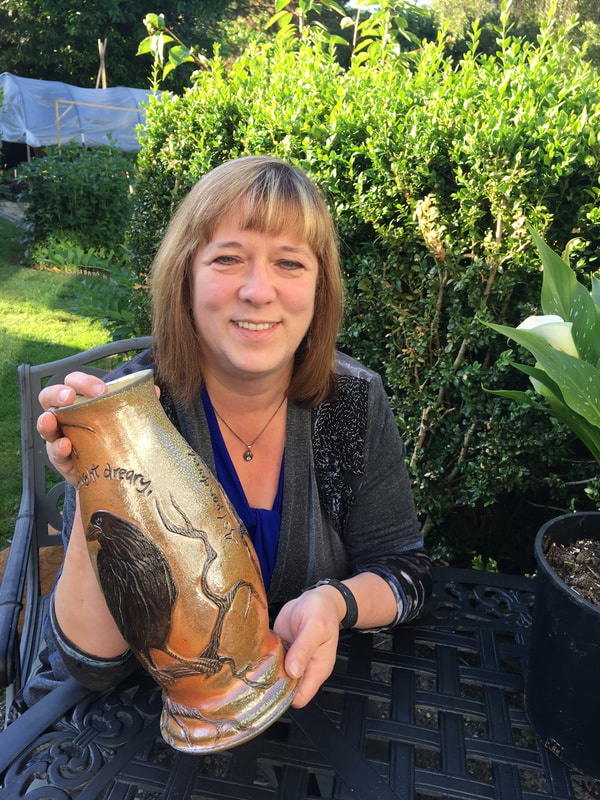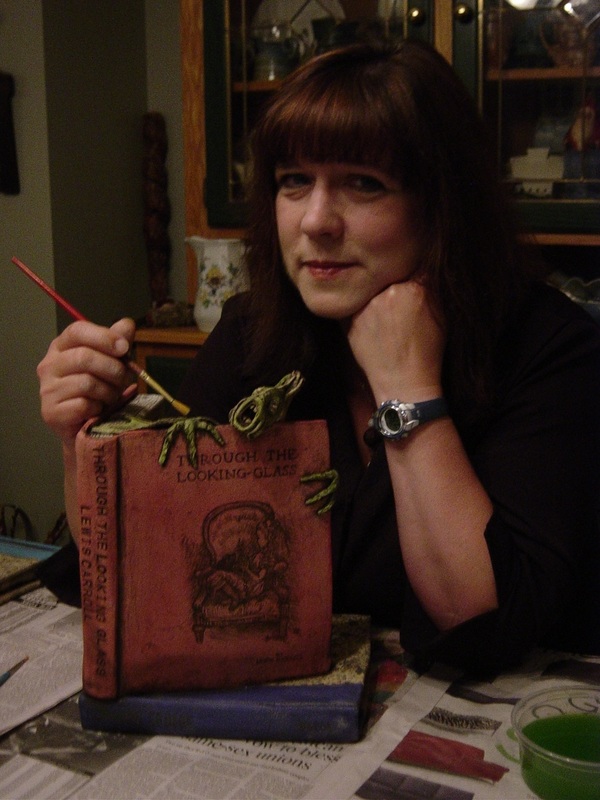|
Soda Firing/MOA Residency and Current Work
Most pieces created in the past two decades, were fired in atmospheric firings at the Shadbolt Centre for the Arts, located at Deer Lake, in Burnaby, B.C. Since 2001, I experimented with gas, wood and soda firings, eventually settling on the unique 'orange peel' finish offered by soda firing, to finish my work. Participants purchase approximately 2.5 cu. ft. of kiln space, create their work either at the Shadbolt, or off site in their own studios, then often assist the Shadbolt Centre technicians with spraying soda into the kiln through port holes, near the completion of the gas firing. Temperature in the kiln reaches 2300 degrees Fahrenheit (or Cone 10). No glaze is used on the outside of the work, just a variety of slips, which attract the soda. The kiln itself was was designed and constructed in 2014, along with a wood-firing train kiln, in 2014, by Indiana ceramics professor and kiln builder, Ted Neal. he had help from his assistant, Collette Spears, the Shadbolt Centre ceramic technicians and a group of dedicated students. Ted was hired to replace the original 'Ombu' wood/soda kiln, built for the Shadbolt Centre as a millennial grant project, by Masakazu Kusakabe, from Japan, in 2001. Guest firers have come from as far away as England, Japan, Australia and throughout Canada and the U.S.A. to fire these kilns at the Shadbolt. Each guest artist has brought new knowledge and techniques with them, enhancing the ceramic programs at the City run facility. After repositioning from my position as Ceramic Arts Programmer for the Shadbolt Centre, in 2017, I was fortunate to be chosen as 'Ceramic Artist in Residence' at Vancouver's Museum of Anthropology, where I spent most of 2019 working in the Judy Cranmer lab, drawing inspiration from the works in the Koerner Collection of European Ceramics. This re-ignited my interest in sculptural/literary subjects and two pieces created during my residency, now reside in the Koerner Collection, near the works that inspired them. As my focus continues in this area, I am drawn to experiment in mid-fire clays and the application of slips and stains in electric firing. This allows me to explore a more illustrative side to my work, to celebrate and share my love for children's literary classics, while helping to promote the importance of reading for all ages. Stay tuned. |
Process: ‘The Book Ends’
|
|
My fascination with children’s literature has always had a tendency to surface in my work. I love to invoke a sense of whimsy and into each piece - to carry the viewer back to a time when life was less complicated and be touched by a bit by magic and childlike innocence.
The ‘Book Ends’ series was created to stress the importance of reading to children, particularly in this age of instant images and technology. I wanted to bring attention to the numerous writers and illustrators, who so enhanced my own childhood – and to encourage parents to introduce some of these classics to a new generation. In tackling this project, I was faced with the dilemma of creating a standardized basic book shape that would allow me to make sets, but also give me the flexibility to alter and individualize each one. my friend and colleague, Linda Doherty (the ‘Extruder Queen’) offered to create a template and extrude the shapes. Using ‘Columbia Buff with Grog (Seattle Pottery Supply), Linda extruded a total of 34 book shapes for me. Earlier in 2007, at Janet Mansfield’s invitation, Linda and I – along with 3 other women artists, attended and presented at a triennial, international symposium, “Clayedge’ in Gulgong , Australia. While there, I discovered some high-fired, brightly-coloured slips and patterned transfer sheets at NSW Pottery Supply, which fit the bill exactly. In order to illustrate both front and back covers, and provide text and illustration on the inside pages, it was necessary to finish off the closed shape, slice off the front cover and replace it with a new slab of clay. Once painting was completed, I re-assembled the book, attach it to another ‘book’ base, then add the characters, which had already been assembled and painted with the coloured slips. Each book end was fired in one piece - with no gluing needed. Once completed, they were dried and bisque-fired in an electric kiln, then a black stain applied and wiped off, before being fired again to cone 9. Upon unloading they were basically finished. All bookends were created on my dining room table, since my studio had been under disrepair at the time. After showing at Crafthouse in 2007, the bookends were on display at several lower mainland locations, including the main branch of the Vancouver library, New Westminster and North Vancouver. Most have been sold over the years, but the ones remaining were recently shown at the West Vancouver Memorial Library, in March of 2021. |

